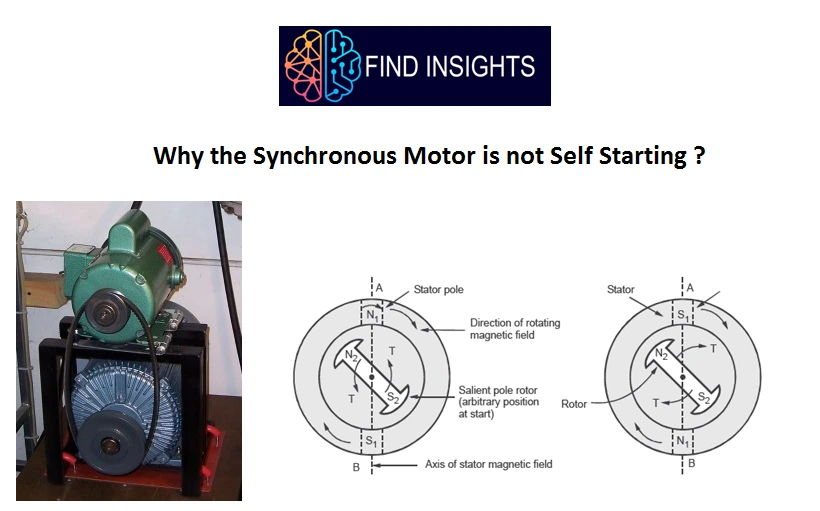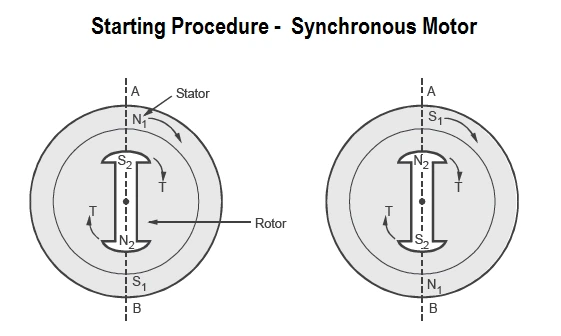
Introduction: Why the Synchronous Motor is not Self Starting
Synchronous motor is not self-starting. It has to be run up to synchronous (or near synchronous) speed by some means, before it can be synchronized to the supply.
The synchronous rotor cannot start rotating on its own or usually we say that the synchronous rotor has no starting torque. So, some special provision has to be made either inside the machine or outside of the machine so that the rotor is brought to near about its synchronous speed. At that time, if the armature is supplied with electrical power, the rotor can pull into step and continue to operate at its synchronous speed. Let’s see in details Why the Synchronous Motor is not Self Starting.
Must Read: WORKING PRINCIPLE OF SYNCHRONOUS MOTOR
Explanation for Why the Synchronous Motor is not Self Starting

- Consider the rotating magnetic field as equivalent to physical rotation of two stator poles N & S1.
- Consider an instant when two poles are at such a position where stator magnetic axis is vertical, along A-B as shown in the figure.
- At this instant, rotor poles are arbitrarily positioned as shown in the figure.
- At this instant rotor is stationary and unlike poles will try to attract each other. Due to this rotor will be subjected to instantaneous torque in anticlockwise direction as shown in the figure.
- Now stator poles are rotating very fast i.e at a speed Ns r.p.m. Due to inertia, before rotor hardly rotates in the direction of anticlockwise torque to which it is subjected, the stator poles change their positions. Consider an instant half a period latter where stator poles are exactly reversed but due to inertia rotor is unable to rotate from its initial position. This is shown in the figure.
- At this instant, due to the unlike poles trying to attract each other, the rotor will be subjected to a torque in clockwise direction. This will tend to rotate rotor in the direction of rotating magnetic field.
- But before this happens, stator poles again change their positions reversing the direction of the torque exerted on the rotor.
- As a result, the average torque exerted on the rotor is zero. And that why the Synchronous Motor is not Self Starting
Starting a Synchronous Motor
- Now suppose the rotor is rotated by some external means at a speed equal to sysnchronous speed. And then the rotor is excited to produce its poles. At a certain instant now, the stator and rotor unlike poles will face each other such that their magnetic axes are near each other. Then force of attraction between the two, pulls both of them into magnetic locking condition.
- Once magnetic locking is established, the rotor and stator poles continue to occupy the same relative positions. Due to this rotor continuously experiences a unidirectional torque in the direction of the rotating magnetic field. Hence the rotor rotates at synchronous speed and said to be in synchronism with rotating magnetic field. The external device used to rotate rotor near synchronous speed can be removed once synchronism is established. The rotor then continues at Ns due to magnetic locking. This is the reason why synchronous motor runs at synchronous speed and does not rotate at any speed other than synchronous. This operation is shown in the figure below.
- It is necessary to keep field winding i.e. rotor excited from d.c. supply to maintain the magnetic locking, as long as motor is operating.
Procedure for Starting a Synchronous Motor

A general procedure to start a synchronous motor can be stated as:
- Give a three phase a.c. supply to a three-phase winding. This will produce rotating magnetic field rotating at synchronous speed Ns r.p.m
- Then drive the rotor by some external means like diesel engine in the direction of rotating magnetic field, at a speed very near or equal to synchronous speed.
- Switch on the d.c.supply given to the rotor which will produce rotor poles. Now there are two field one is rotating magnetic field produced by stator while other is produced by rotor which is physically rotated almost at the same speed as that of rotating magnetic field.
- At a particular instant both the fields gets magnetically locked. The stator field pulls the rotor field into synchronism. Then the external device used to rotate rotor can be removed. But rotor will continue to run at the same speed as that of rotating magnetic field I.e Ns due to magnetic locking.
- Based on the above explanation it is clear that to start the synchronous motor , it needs some device to rotate the rotor at a speed very near or equal to the synchronous speed.
LIKE WHAT YOU’RE READING?
CHECK OUT SOME OF OUR OTHER GREAT CONTENT HERE:
- WHAT IS A UNIVERSAL MOTOR ?
- LVDT- CONSTRUCTION, WORKING PRINCIPLE , APPLICATIONS, ADVANTAGES, AND DISADVANTAGES
- HOW AN IGBT WORKS?
- SCR VI CHARACTERISTICS EXPLAINED IN DETAIL
- STEP UP TRANSFORMER: DEFINITION, CONSTRUCTION, WORKING & APPLICATIONS
- LIMITATIONS OF OHM’S LAW
- INDUCTION MOTOR: WORKING PRINCIPLE, TYPES & APPLICATION
- STRAIN GAUGE WORKING PRINCIPLE
- TYPES OF LIGHTNING ARRESTER
- WHAT IS OPERATING SYSTEM AND ITS TYPE
- WHAT ARE THE USES OF CAPACITOR




9 Comments